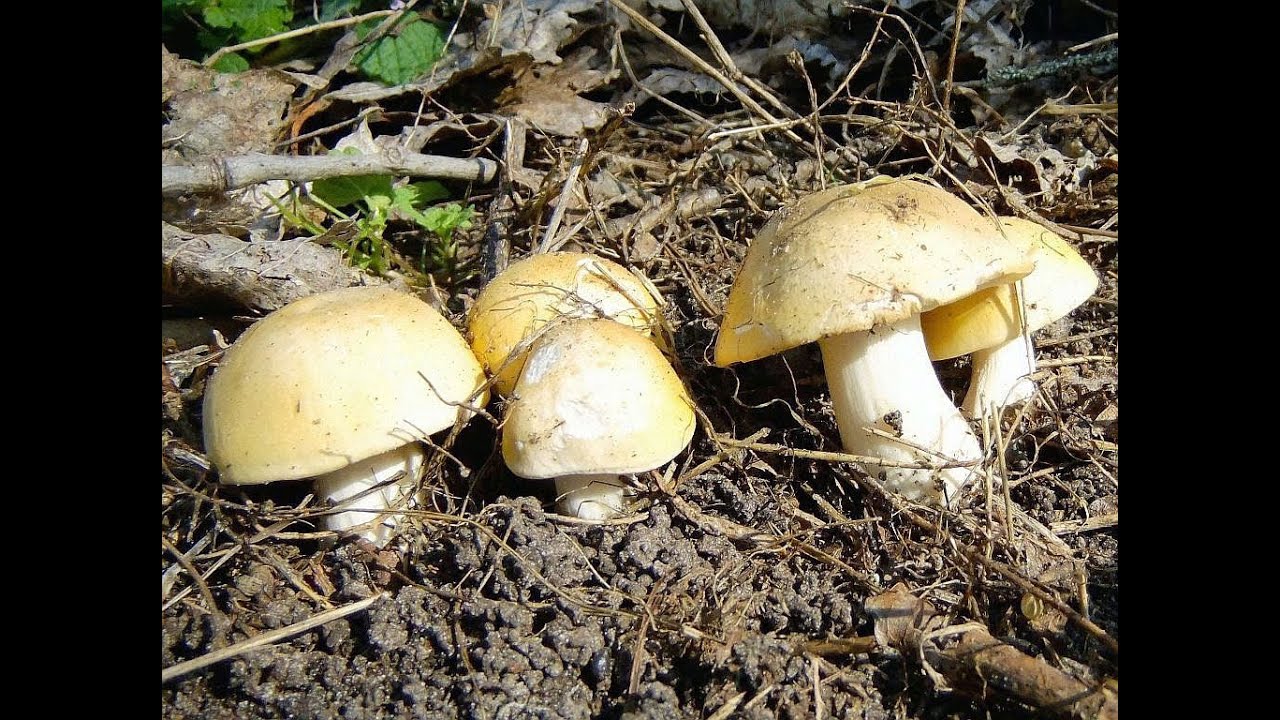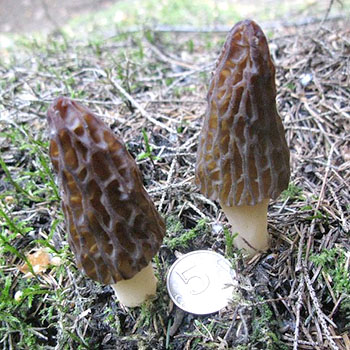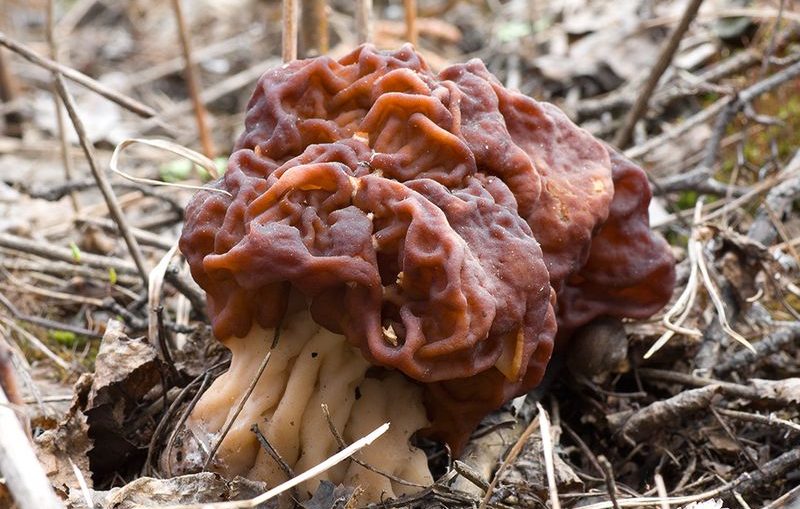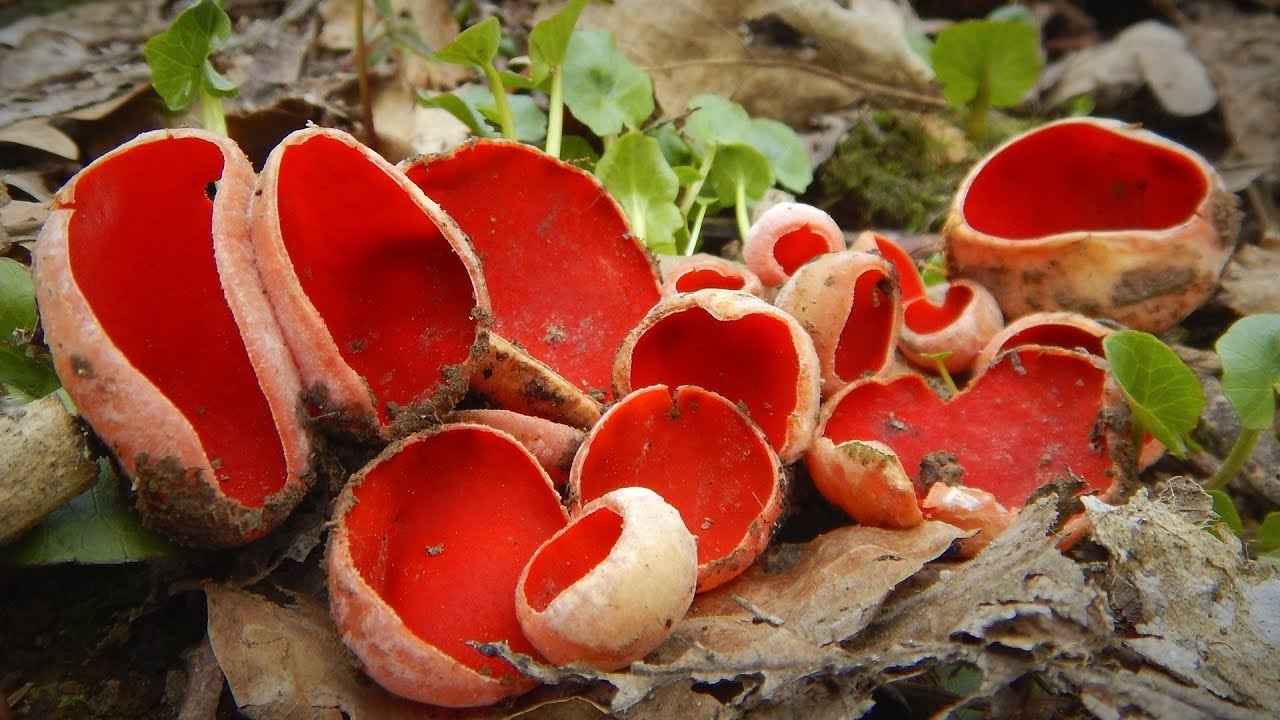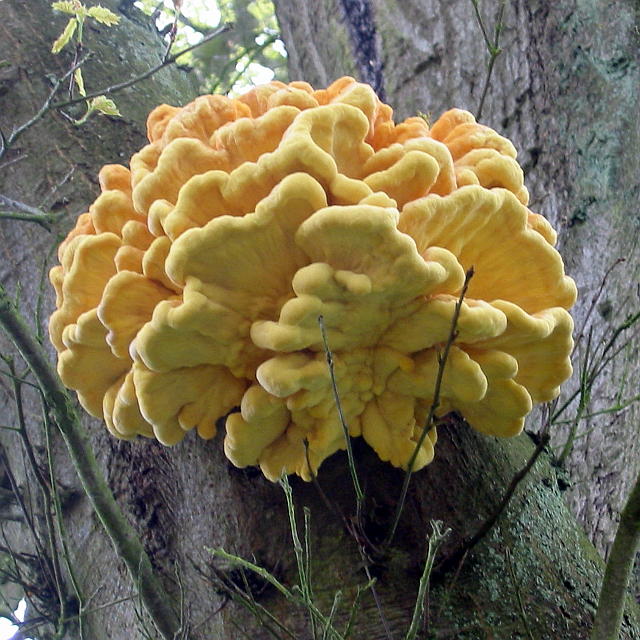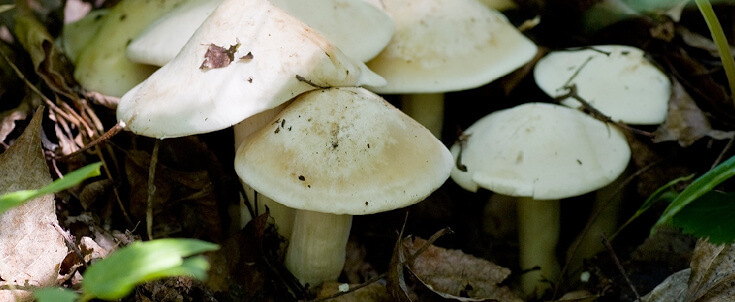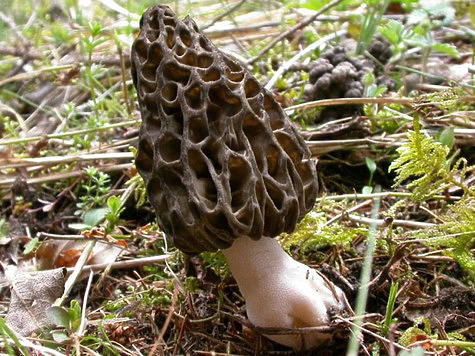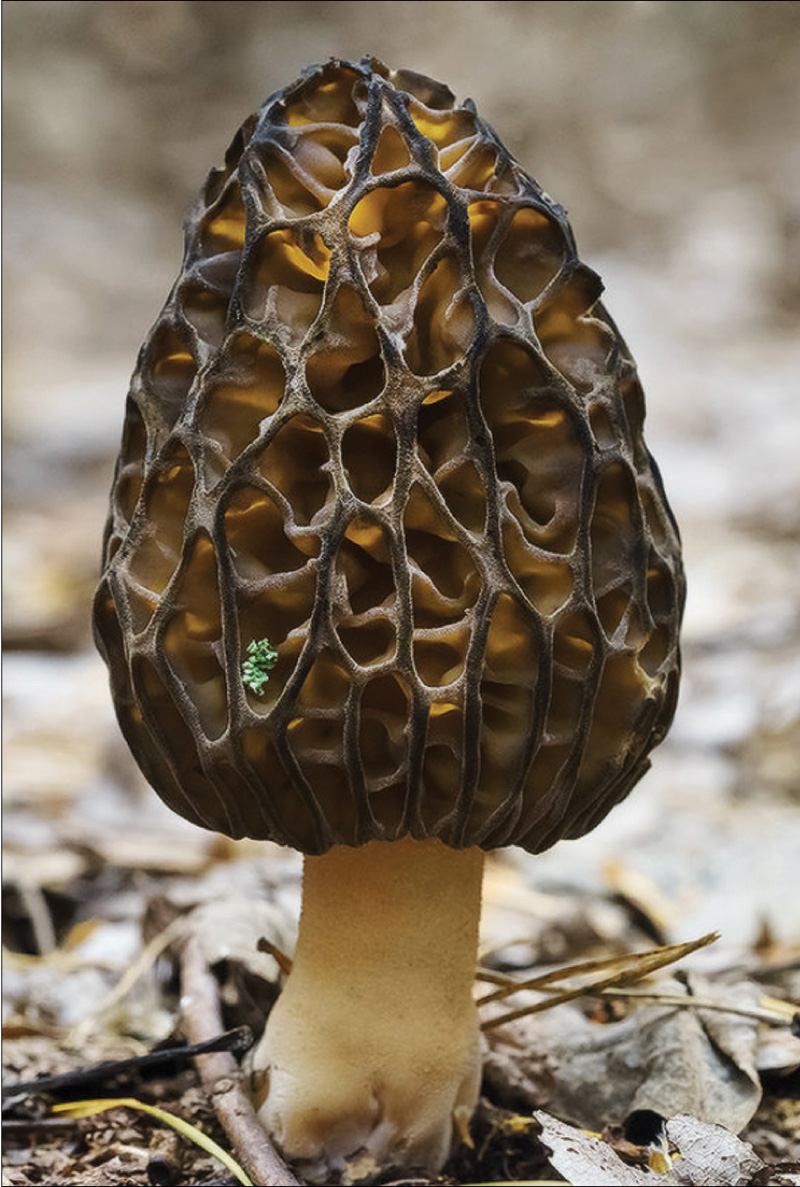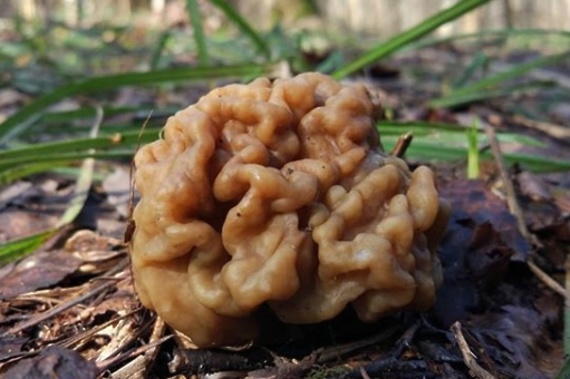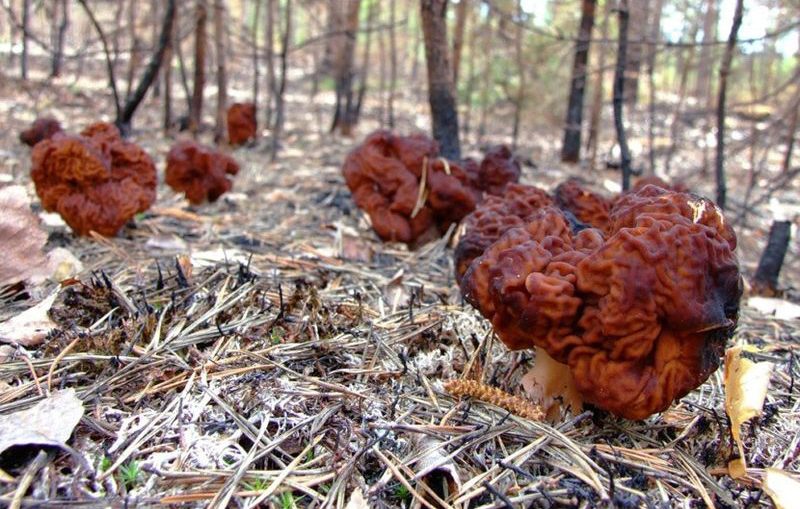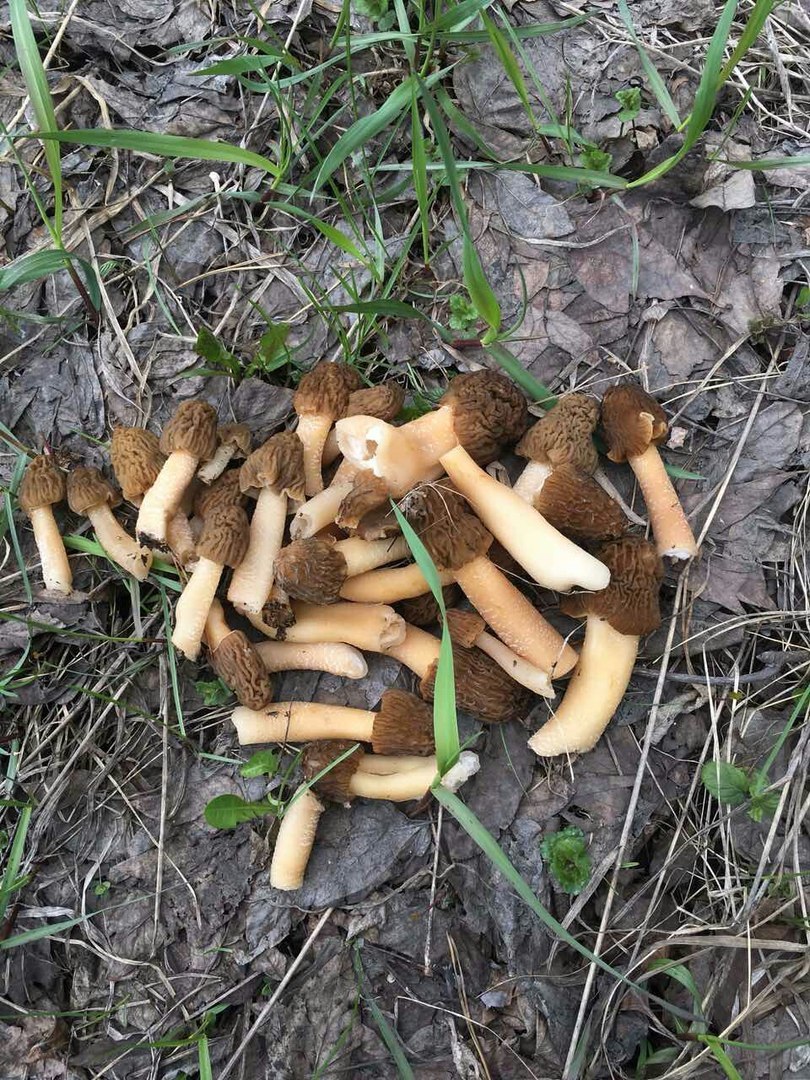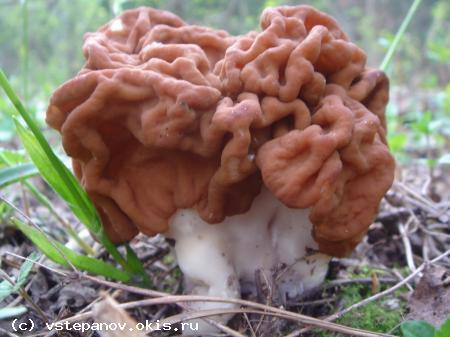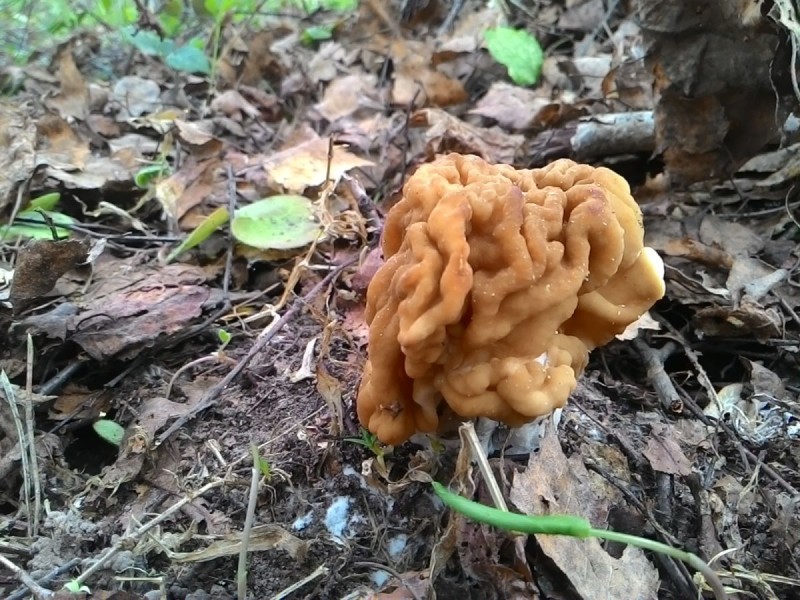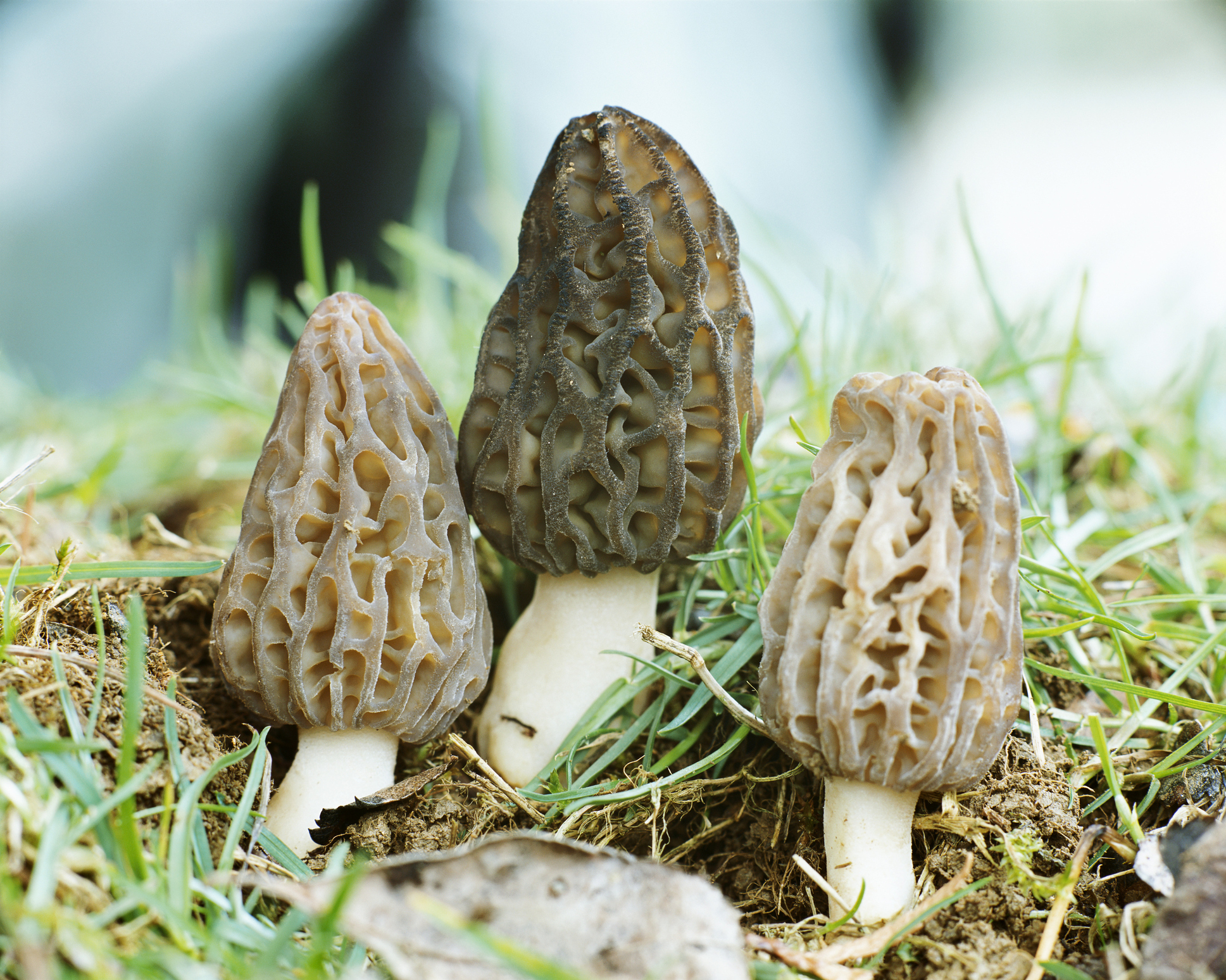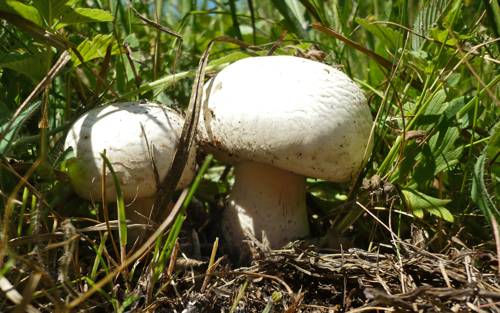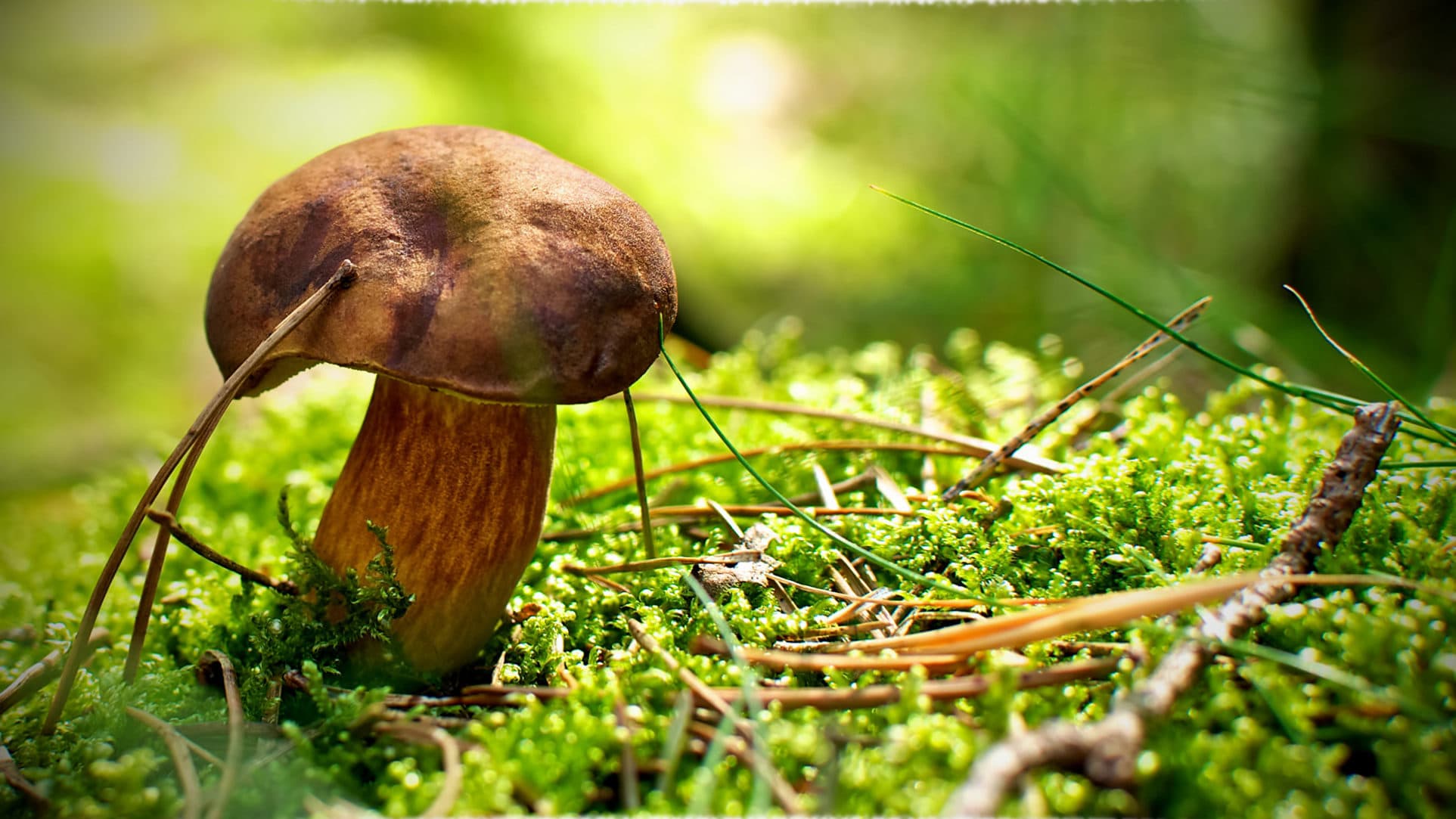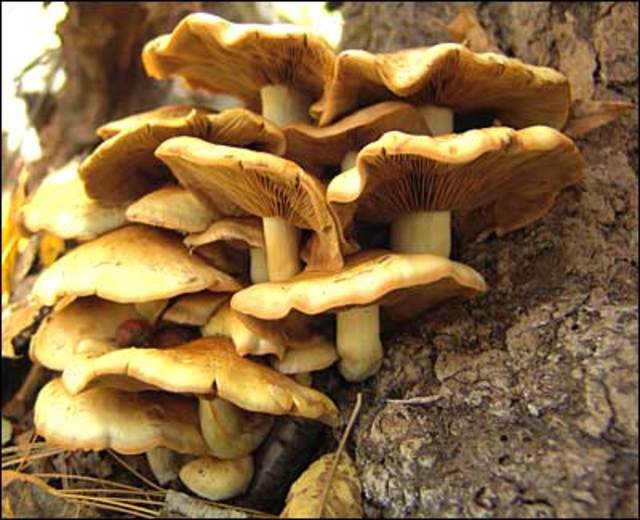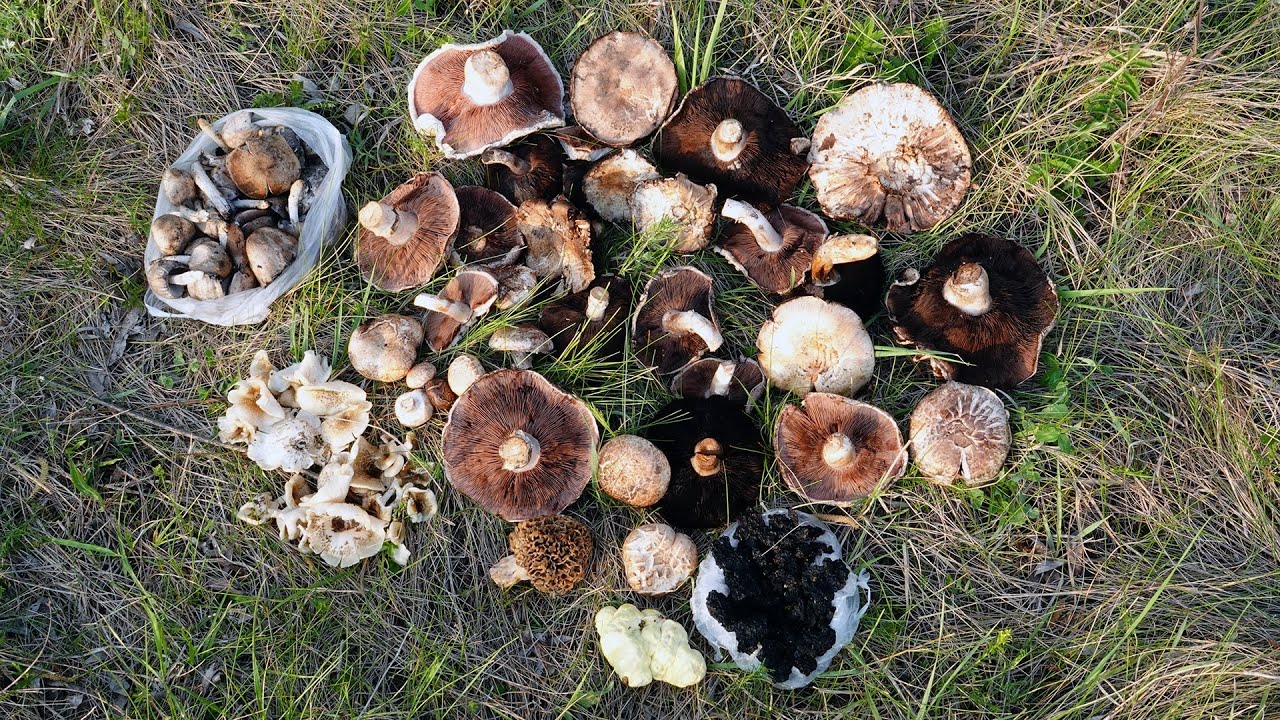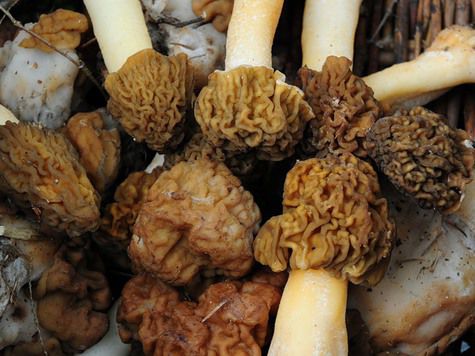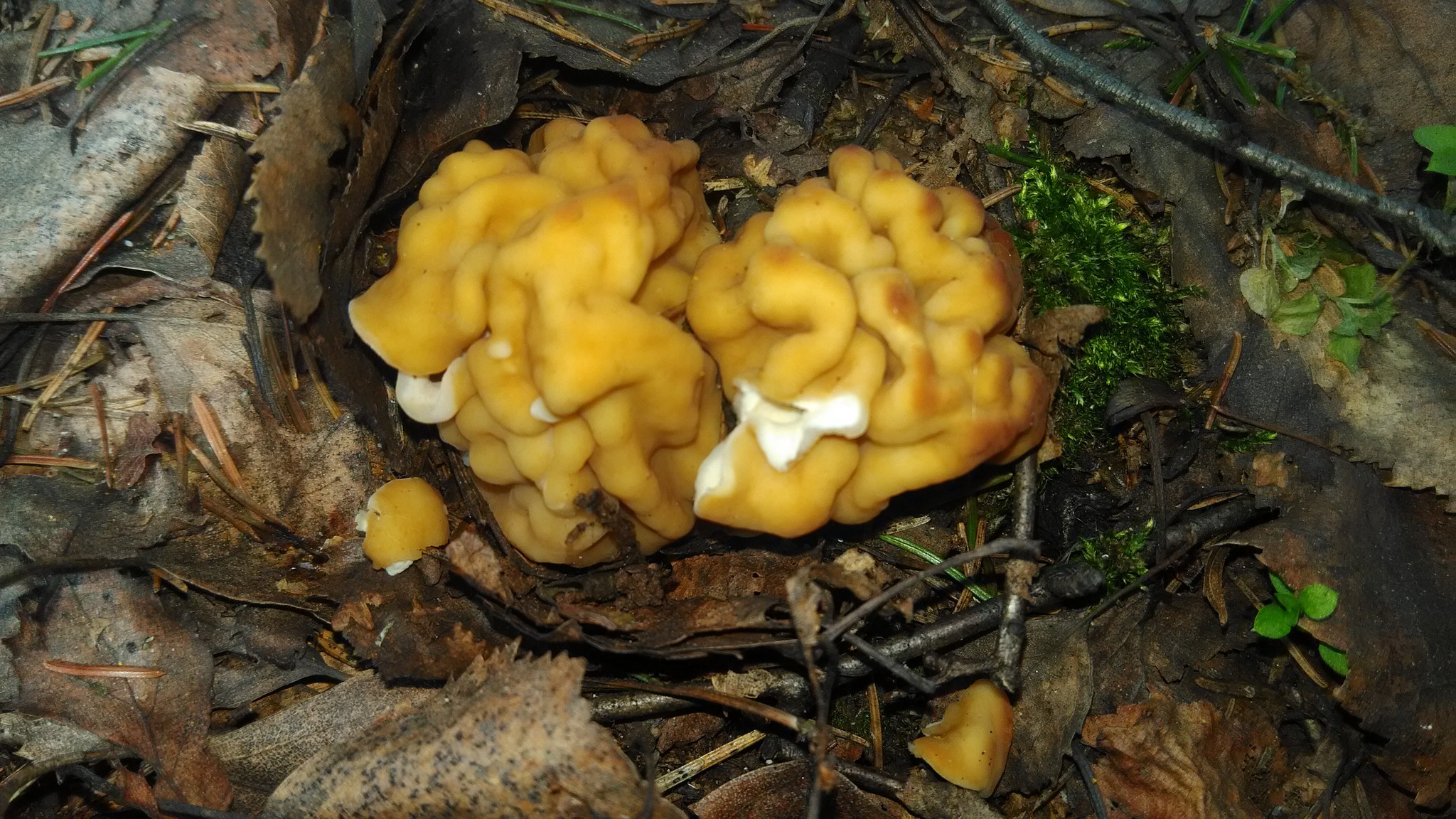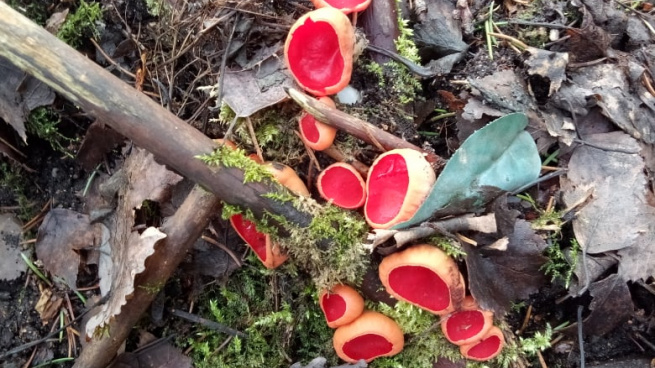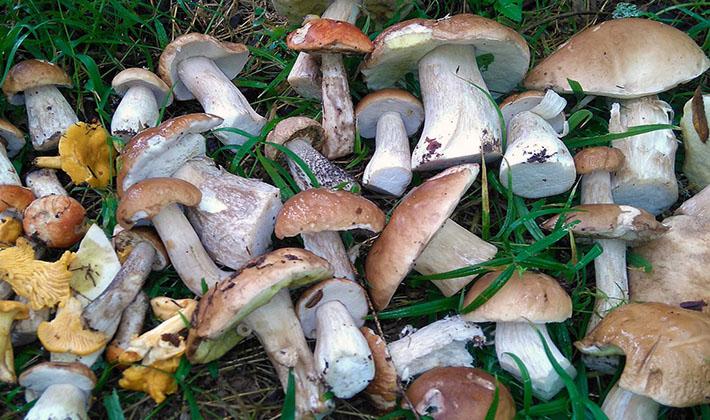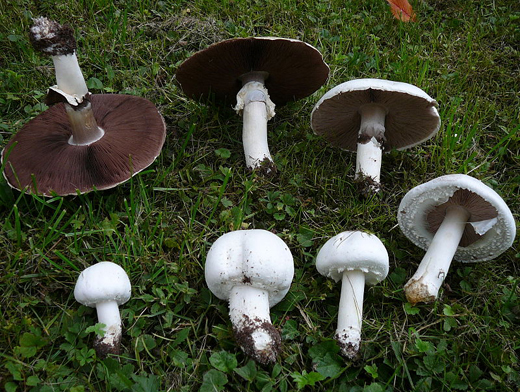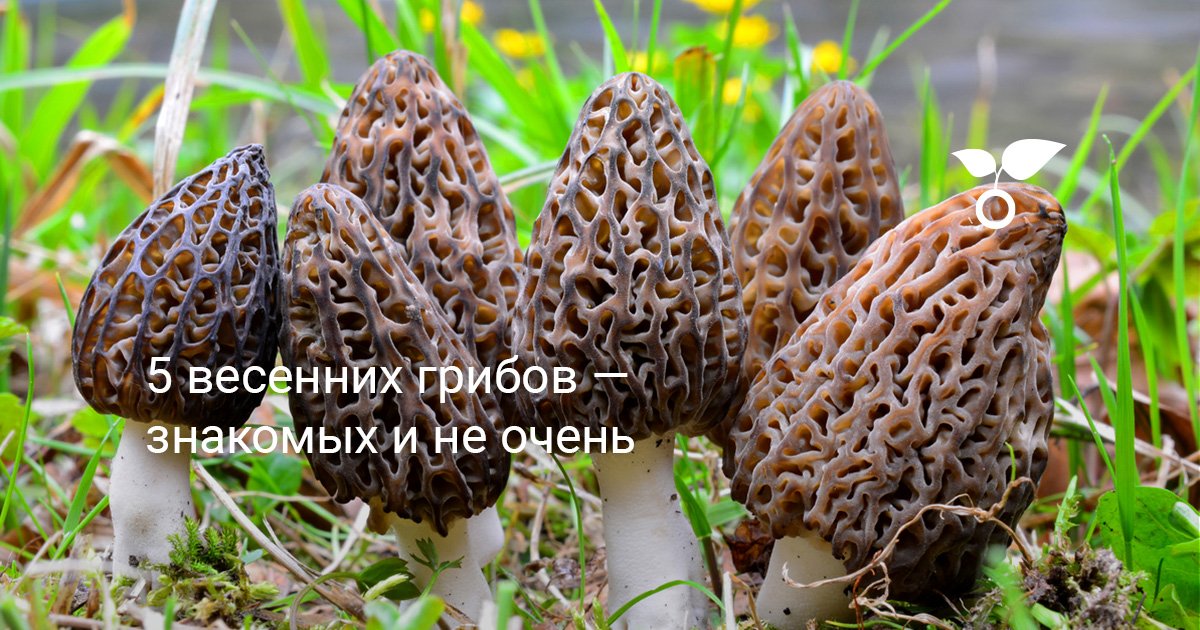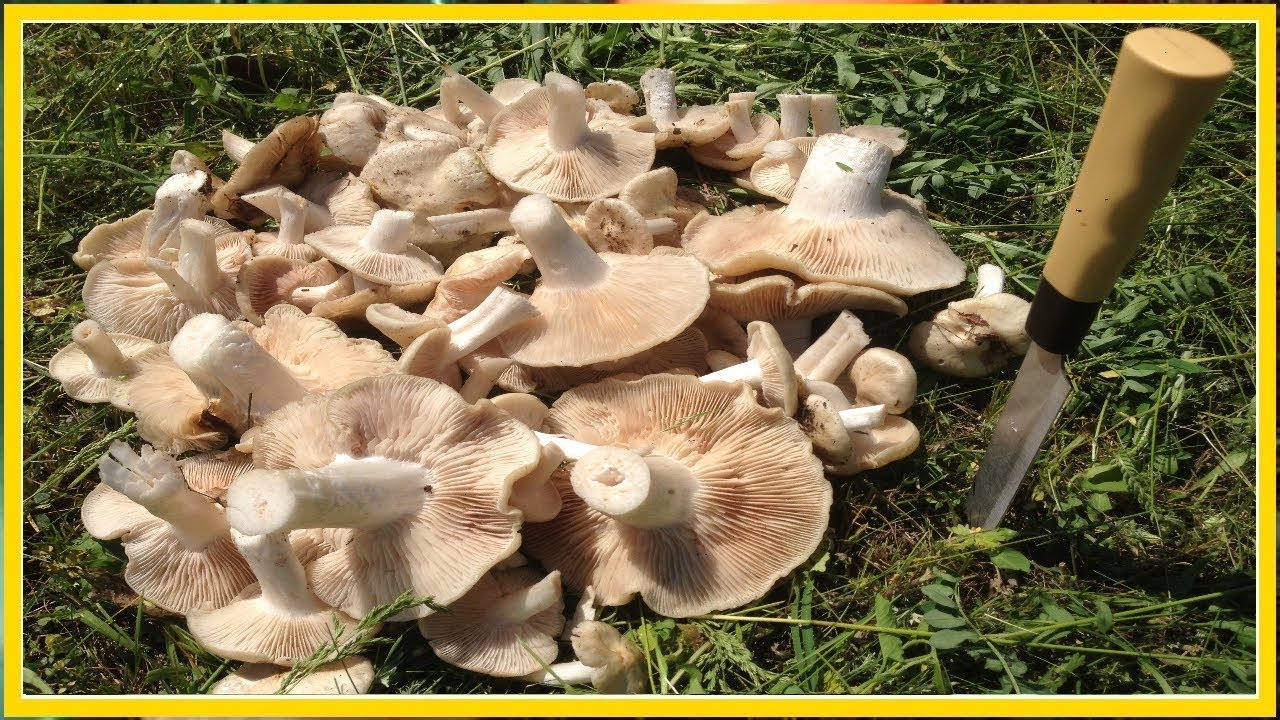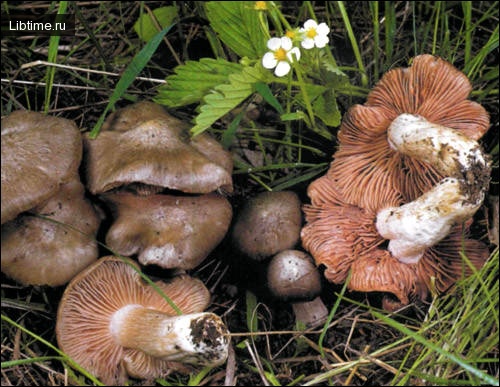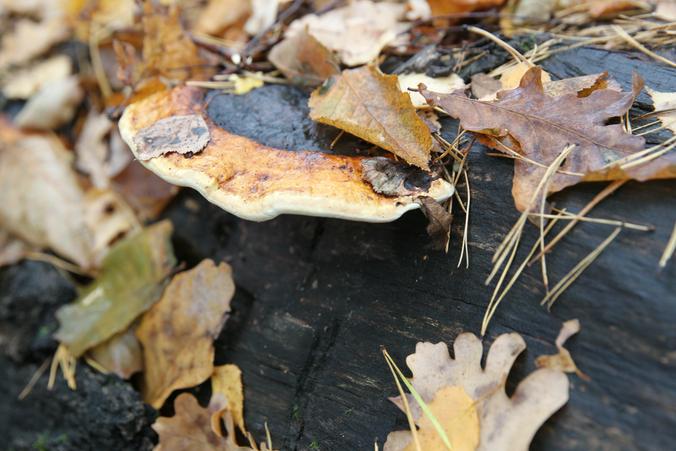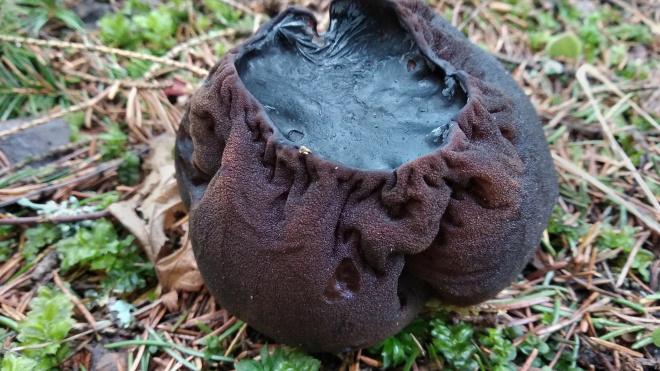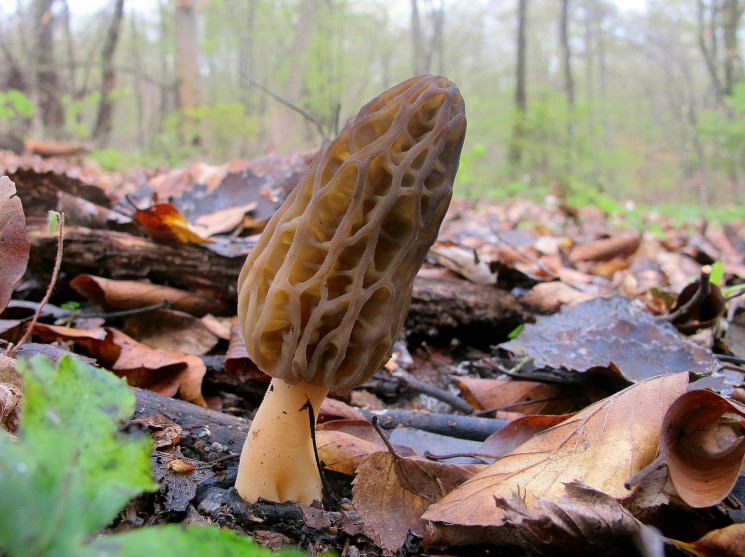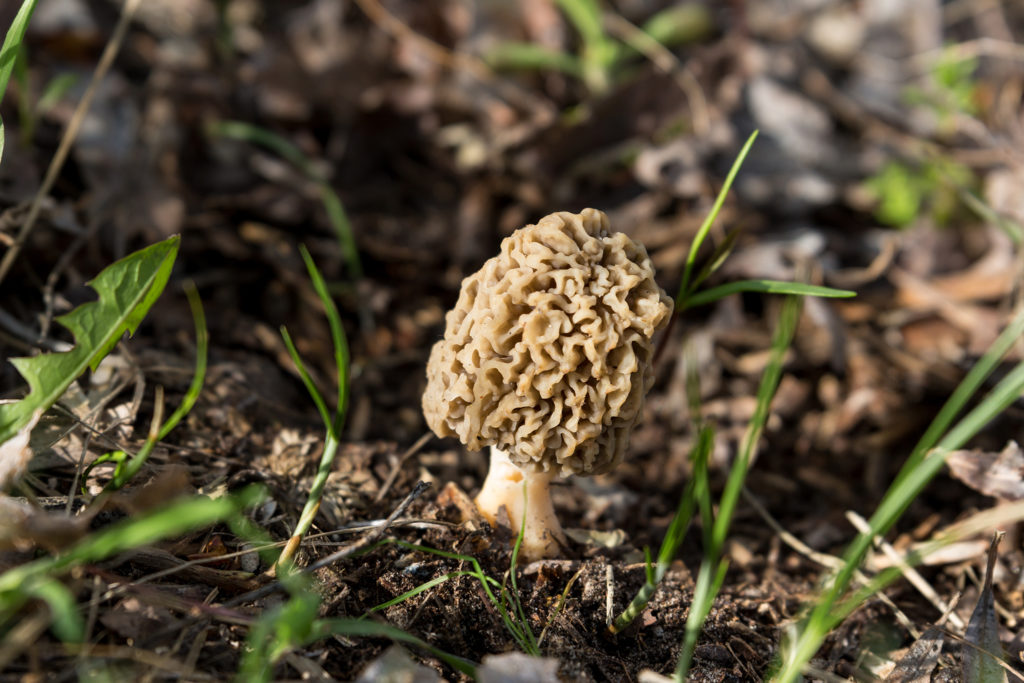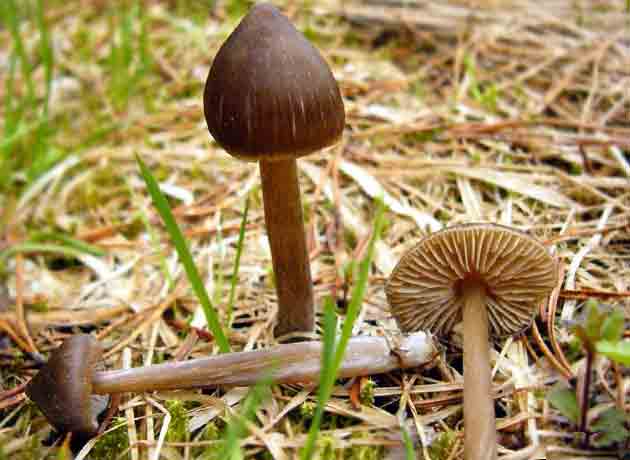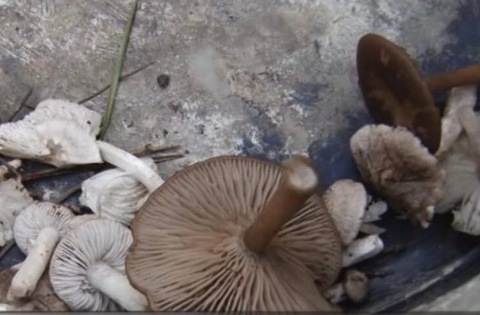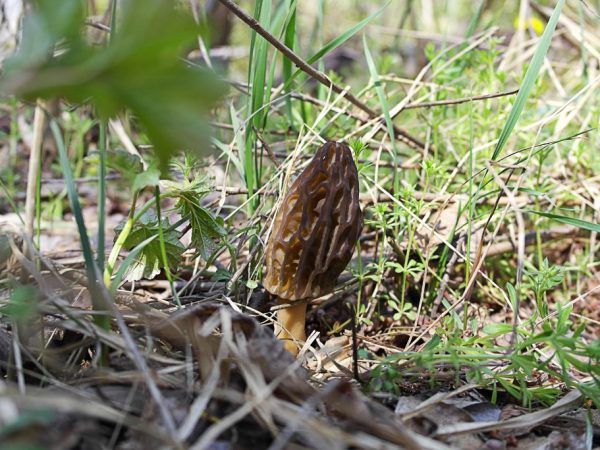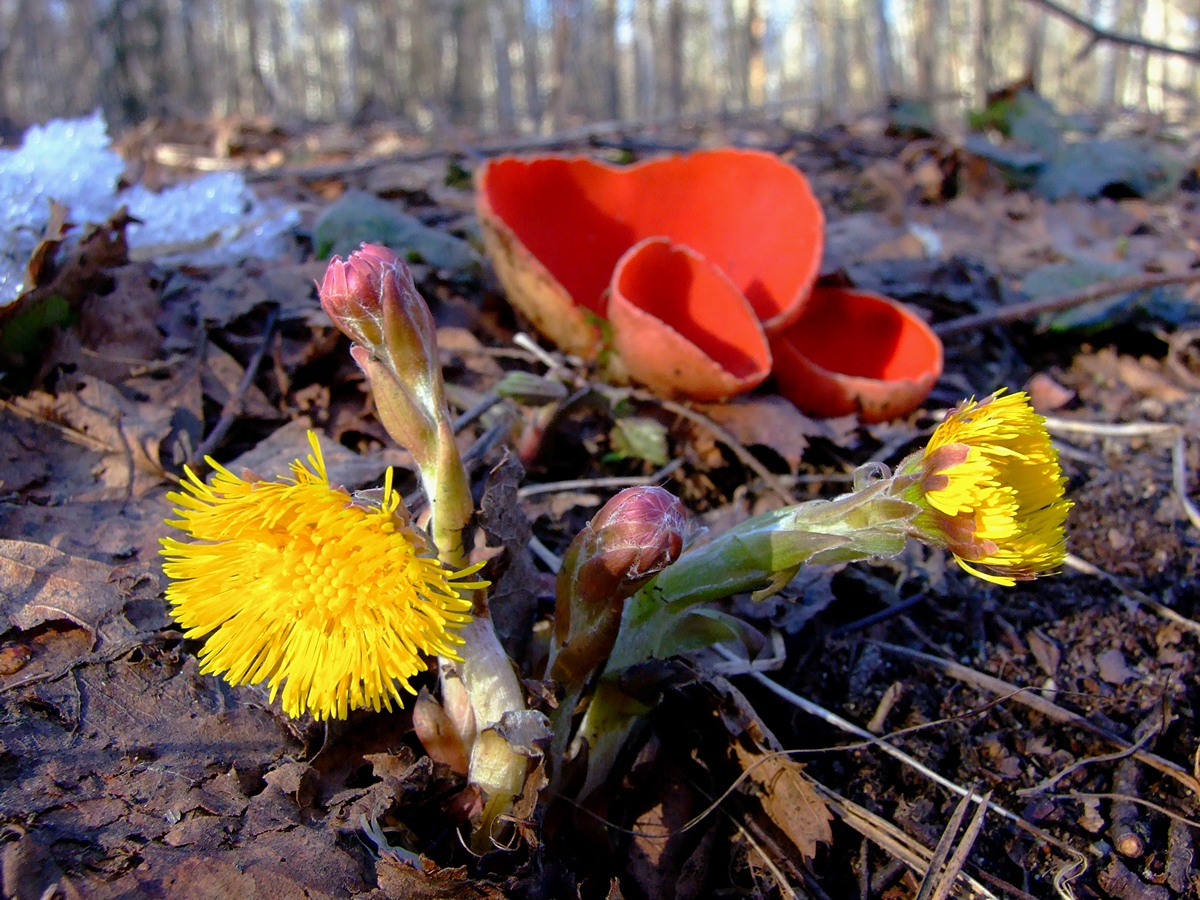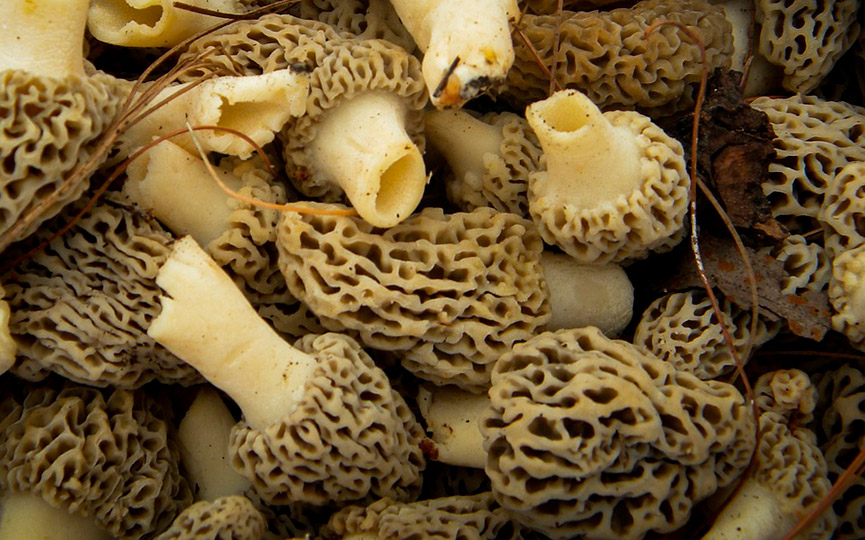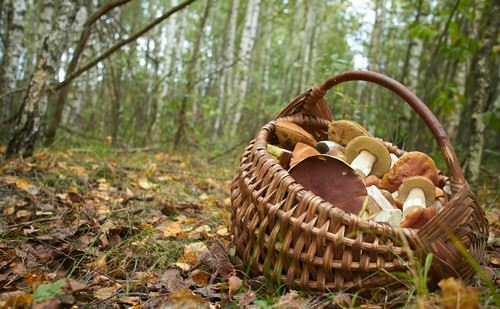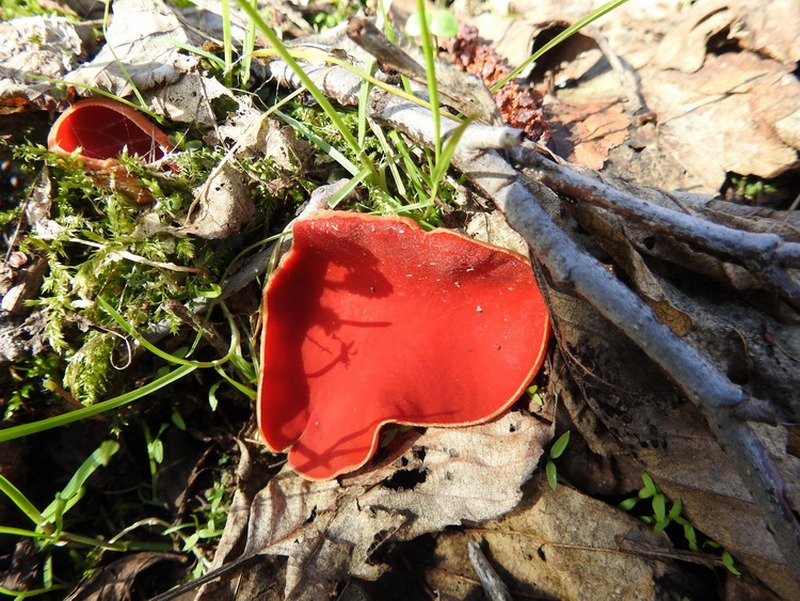Honey mushrooms
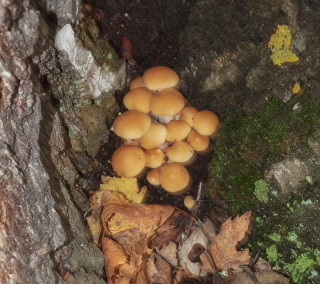
Honey mushrooms come across wherever there are trees or shrubs. Their fruiting bodies can be found both on old stumps and on living trees - on trunks and roots. Rumor has it that even on herbaceous plants, these fungi are capable of parasitizing, for example, on potatoes.
Honey mushrooms usually grow with end of August until the end October - in three layers, but they can give a wave in early July - under favorable conditions.
There is one type of honey fungus (although it has nothing to do with real mushrooms) that can grow at low temperatures. This is the so-called winter honey agaric. You can meet him in the trees from autumn to spring. In warm, mild winters, it bears fruit all season, but usually appears during thaws. Only experienced mushroom pickers collect it, because this mushroom has false poisonous "doubles", very similar to it. Abroad, it is cultivated as oyster mushrooms and mushrooms, where it is known under the Japanese name "enokitake". The cultural form of winter honeydew is very different from the natural one - it has a white color, as well as thin, elongated legs and small caps.
What are the edible types of mushrooms that grow in the garden in spring
Spring mushrooms can be found not only in the forest, but also in gardens. Some of them grow on fruit trees that are found only in the southern regions of Russia, for example, the village of Nizhnekundryuchenskaya of the Rostov region, districts of the Krasnodar Territory, Crimea. And others can also be found on their own site - for example, unpretentious oyster mushrooms can establish a colony on any rotted stump or fallen tree. Below is a list of the most common species that have been growing since the beginning of March.
Oyster mushrooms
This is one of the most unpretentious mushrooms. They always settle on old, dying wood and almost never on living, well-growing trees. Sometimes oyster mushrooms can be found on old sawdust, snags, even ash. The substrate for them does not really matter, therefore, in artificial conditions, they are often grown on cake, husk or cotton wool.
They look light, milky and grayish. They always grow only in groups. They have a pleasant mushroom aroma: if a rotten smell is detected, such a mushroom should not be taken. Oyster mushrooms have a fleshy leg, although the fruiting body mainly consists of a large cap with a diameter of 15 to 25 cm.
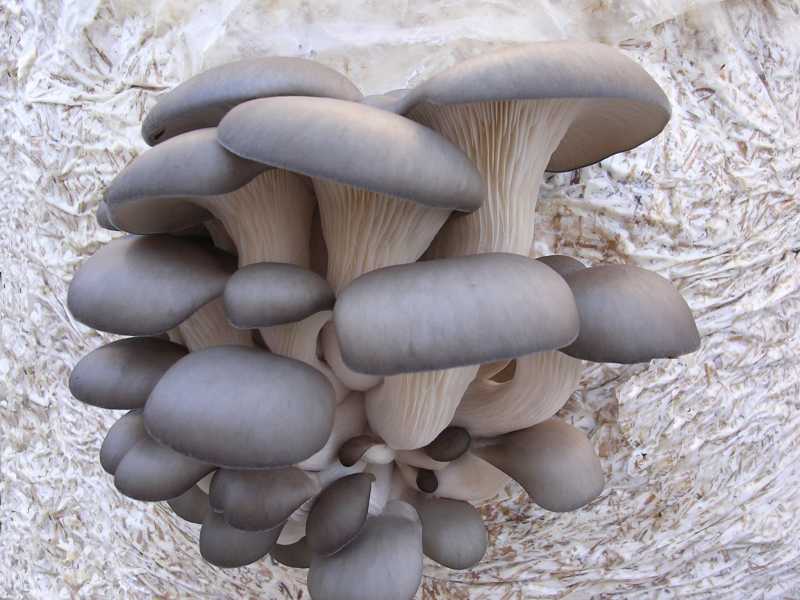
Oyster mushrooms
Meadow mushrooms
These mushrooms cannot be attributed to the earliest, since they appear in early May, however, they are quite widespread in the southern regions and in general in the European part of Russia. They grow among meadow flowers and plants - in gardens and on forest edges.
Despite its small size (the hat is less than a centimeter in diameter), the honey mushroom almost never grows alone - it forms families of 1.5-2 dozen. It has a pleasant color similar to the blush of baked goods. The smell is very pleasant, but the pulp has practically no pronounced taste. Therefore, such mushrooms are often dried and then used in the preparation of sauces for the second courses.
Champignon
Distributed not only in the garden and forests, but also in large park areas of cities, in ravines and glades. They prefer to grow under poplars, acacias or chestnuts. Since champignons do not like winds, they can be found in large quantities in forest shelter belts, as well as in cultivated fields that are surrounded by moats.
They grow in colonies of several pieces. The caps are white, fleshy, and have a pleasant aroma. With age, they begin to turn gray, and, as a rule, wormholes appear in them - such mushrooms should not be collected. Champignon is one of the classic, common mushrooms, and is similar in taste to boletus.

Champignon
Raincoats
These are mushrooms that look like a ball on the ground, since their fruiting body is represented only by the cap.There are three varieties of raincoats that are found in gardens and forests from April to June:
- gigantic flap;
- bighead;
- spiky raincoat.
IMPORTANT
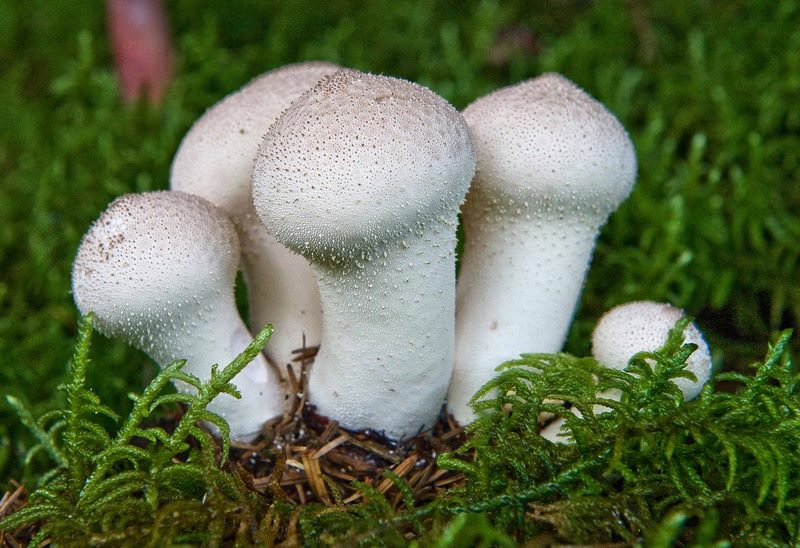
Raincoats
Podbrikosovik, podvyshennik, podlivnik
This mushroom has a pleasant pinkish-orange color, therefore it is also called thyroid rosacea. It is found only in the southern regions next to apricot trees: in ravines and gardens.
It has a low, dense leg. Hat with orange plates, which are somewhat darker in older representatives. At the same time, the pulp is white and at the break it has a pleasant, rich aroma. Such mushrooms are used in any form: fried, boiled, but the most delicious are pickled ones.
Edible podlivniks and whiskers are related to podrikosovik, which, along with these fruit trees, are also found under pear, apple, blackthorn and hawthorn trees.
IT IS INTERESTING
Colibia Edible Mushroom

In the middle and end of May, the first types of collibies appear. These include, first of all, chestnut or oily colibs. These cute little mushrooms attract with their spectacular appearance, although they are small in size. Although they are edible, they are not harvested due to their small size and the lowest, fourth category for food properties.
Habitats of the chestnut or oily collybia (Collybia butyracea): mixed and coniferous forests, on the forest floor, on rotting wood. These mushrooms usually grow in groups in the spring forest.
Season: May - October.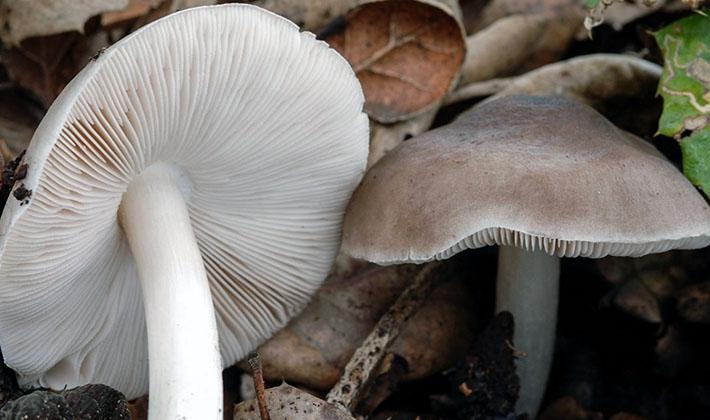
The cap has a diameter of 3-8 cm, at first hemispherical, later convex with a round tubercle and then prostrate with a flat tubercle and raised or curved edges. A distinctive feature of the spring mushroom called colibia is the chestnut brown color of the cap with a flat tubercle of a darker brown color and light, cream or light brown edges.
Stem 4-9 cm tall, thin, 2-8 mm thick, cylindrical, smooth, creamy at first, later fawn-brown. The base of the leg is thickened.
The pulp is watery, thin, soft, whitish or yellowish, odorless at first, later with a faint moldy odor.
The plates are creamy or yellowish, notched-adherent. Short free plates are located between the adherent plates.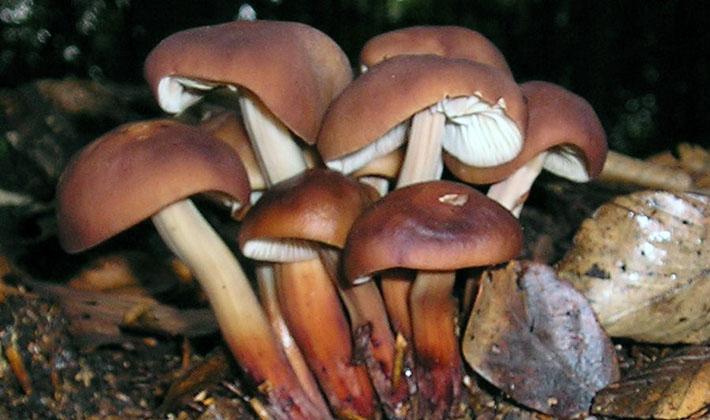
Variability: The color of the cap is variable depending on the maturity of the fungus, the month and the humidity of the season. The color can be chestnut brown, especially in early summer, red-brown with a brown tint, brown-brown with a dark middle, gray-brown with an olive tint, lilac brown. In the dry season, the cap fades to light shades of yellow, cream and light brown.
Edible: edible, but requires pre-cooking in 2 waters to eliminate mold odor. Belong to the 4th category.
Strobilurus edible and cuttings
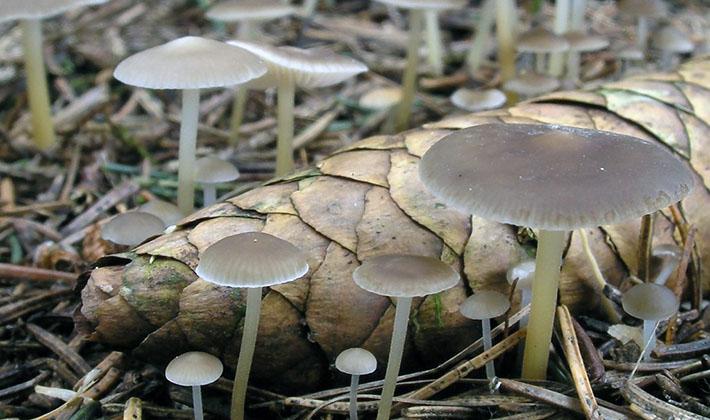
After the snow melts, the first spring edible mushrooms the size of a ten-kopeck coin appear in the forest on scattered cones and on a spruce bedding. They are called strobiliuses. These early spring mushrooms grow in groups. Although they are edible, strobiliuses are not very tasty and difficult to collect due to their small size.
Photos and descriptions of spring strobilirus mushrooms of different species are presented below: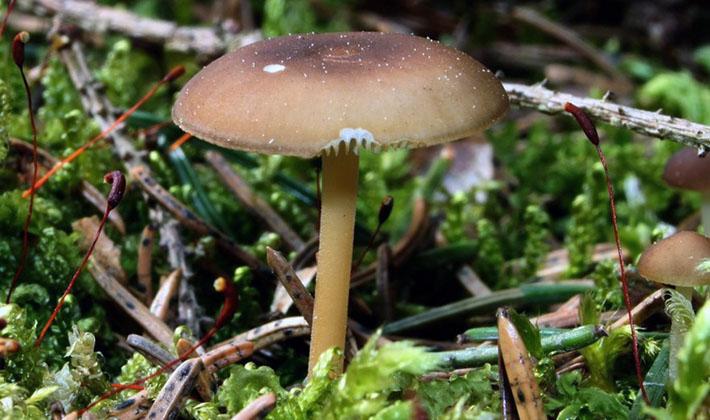

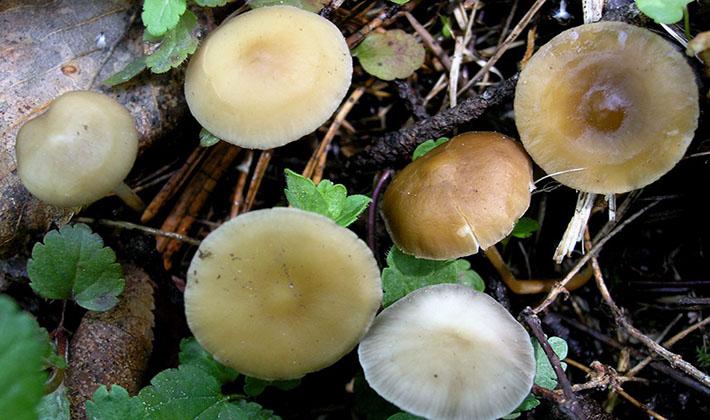
Strobilurus edible, or juicy (Strobilurus esculentus).
Habitat: spruce forests, on spruce bedding or on cones, grows in groups.
Season: early mushroom, April-May.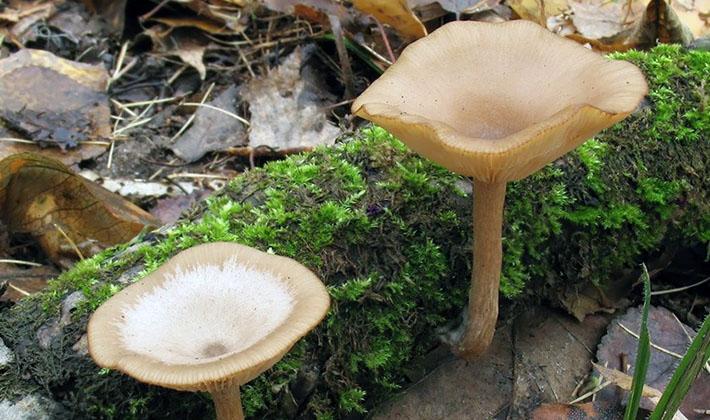
The cap is 1-2 cm in diameter, sometimes up to 3 cm, at first convex, later spread out, flat. A distinctive feature of the species is a brownish or chestnut slippery cap with a tubercle in the center and a thin edge. The color in the center of the cap is darker, brownish brown.
As you can see in the photo, these spring mushrooms have a thin stem, 3-5 cm high and 1-3 mm thick, cylindrical, yellowish on top, yellowish-brown below:
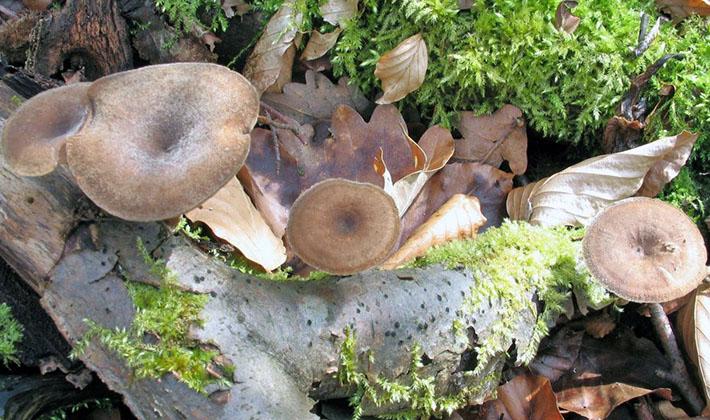
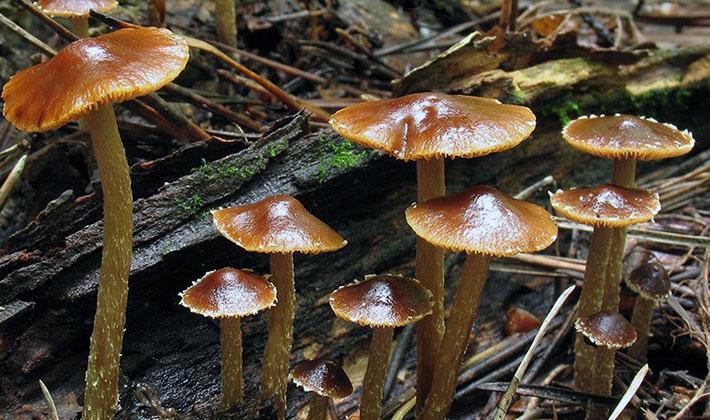
The second distinctive feature of the species is the presence of a long shaggy rooting with woolly strands stretching towards the bump.
The pulp is white, dense, with a pleasant, at first with a slightly pungent odor, later with a slightly herring odor.
Plates of medium frequency, notched-attached, at first white, later yellowish. Spore powder white.
Variability: The color of the cap varies from brownish to brownish brown.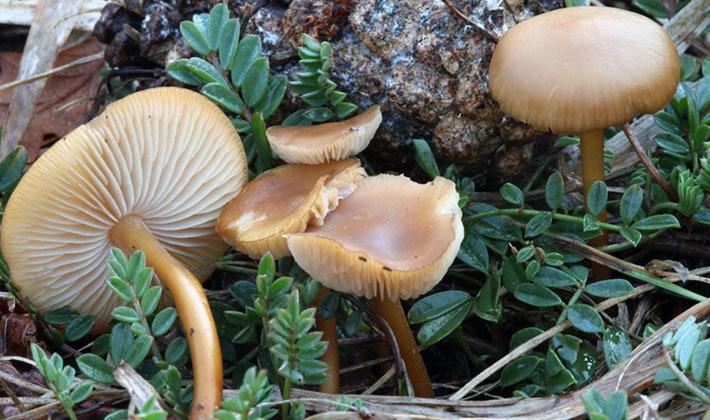
Similar species. The edible strobilurus is similar to the edible cuttings strobilurus (Strobilurus tenacellus), which is distinguished by a more convex yellow-brown cap.
These first spring mushrooms are edible and fall into the 4th category. Only young caps are used for food; they are fried after preliminary boiling for 15 minutes.
Cutting strobilurus (Strobilurus tenacellus).
In addition to edible strobiluriuses, there are also inedible Lai, which are distinguished by a herring smell. They are called cuttings strobiliuses.
Habitat: pine and spruce forests, on litter or cones, grows in groups.
The harvesting season for these spring mushrooms is May-June.
Hat 0.7-1.5 cm in diameter, sometimes up to 2 cm, convex at first, later prostrate, flat. A distinctive feature of the species is a light brown, pinkish-brown matte cap with a blunt tubercle in the center, uneven and with a slightly tubular thin edge.
The leg of these mushrooms, growing in spring in the Moscow region, is thin, 2-5 cm high and 1-2.5 mm thick, cylindrical, cartilaginous, often pubescent at the base, white above, yellowish below. The second distinctive feature of the species is the presence of a long hairy rooting with woolly strands stretching towards the bump.
Look at the photo - the flesh of these mushrooms, which are one of the first to appear in spring, is white, dense: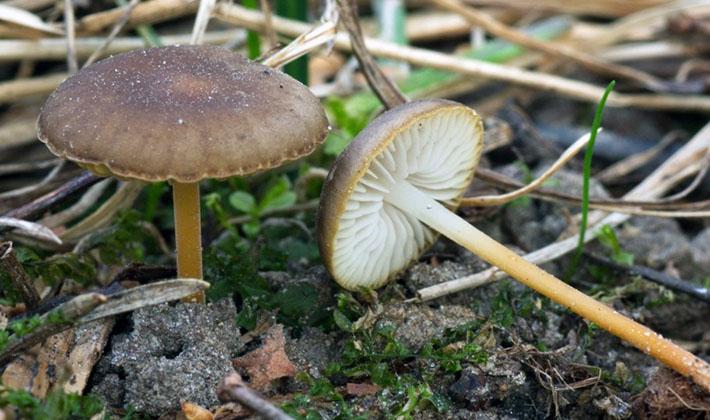
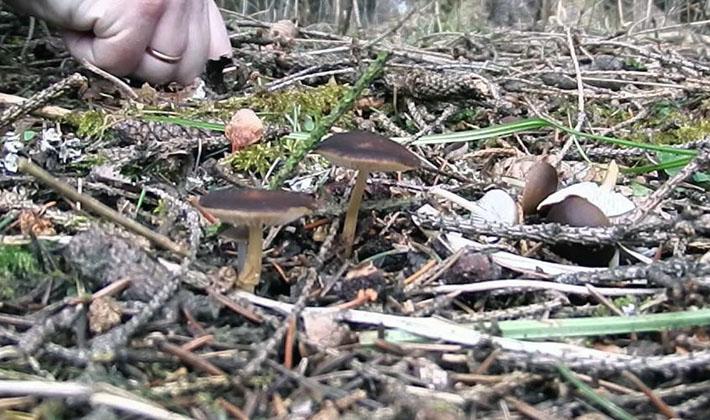
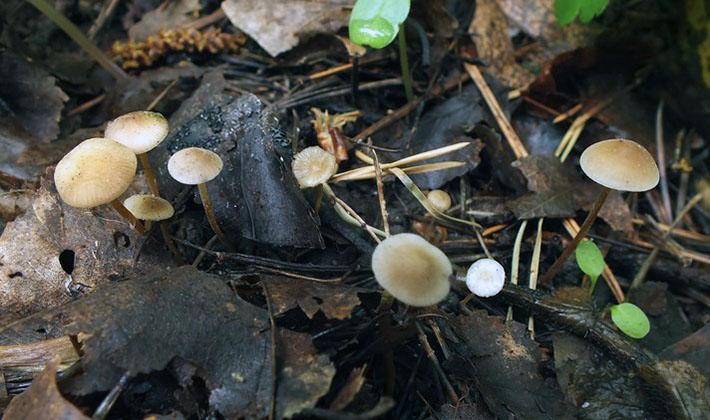
At first, the smell of the pulp is pleasant, slightly herring later becomes unpleasant, gives off a little mustiness.
Plates of medium frequency, notched-attached, at first white, later yellowish. Spore powder is white.
Variability: The color of the cap varies from brownish to brownish brown.
Similar species. Cutting strobilurus is similar to edible strobilurus (Strobilurus esculentus), which differs in a shinier cap with a darker brownish-brown tint, a more brightly colored stem, and a less strong odor.
Raincoats
These are spring mushrooms of the Moscow Region, which appear after the May, already warm rains in birch and pine forests. Round white raincoat heads can be seen at this time. These mushrooms, as such, do not have a stem and a cap. Their body is uniform and shaped like a pear or a ball. They are painted in snow-white or grayish-white color.
There are three types of raincoats:
- thorny raincoat;
- bighead;
- gigantic flyworm.
A spiny raincoat and a small head are in the shape of a light bulb, a giant flute is a ball. The golovach and the giant flail have a smooth white skin, which is easily separated from the fungus when you press on it with your hand. A prickly raincoat is a small mushroom, no more than ten centimeters high, with a scaly surface. Spring mushrooms raincoats can be eaten only when they are very young, and their flesh is snow-white and elastic.
In aging mushrooms, the pulp becomes yellowish. Such a mushroom is already inedible. Raincoats are delicious fried. You must first peel the skin. You do not need to boil them. Unlike other mushrooms, the slicker does not emit mucus when fried and, when fried, resembles French fries with the taste of young tender meat.
And these mushrooms have a double - a poisonous pseudo-raincoat. It has a grayish-yellowish shell, and the flesh is dark purple with an unpleasant swing.
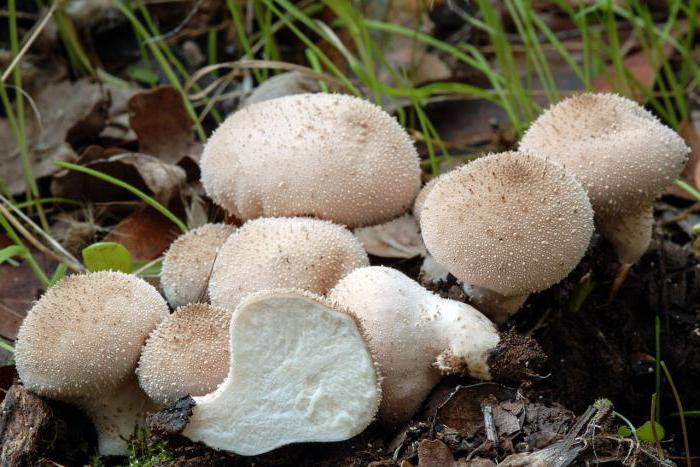
Obabki
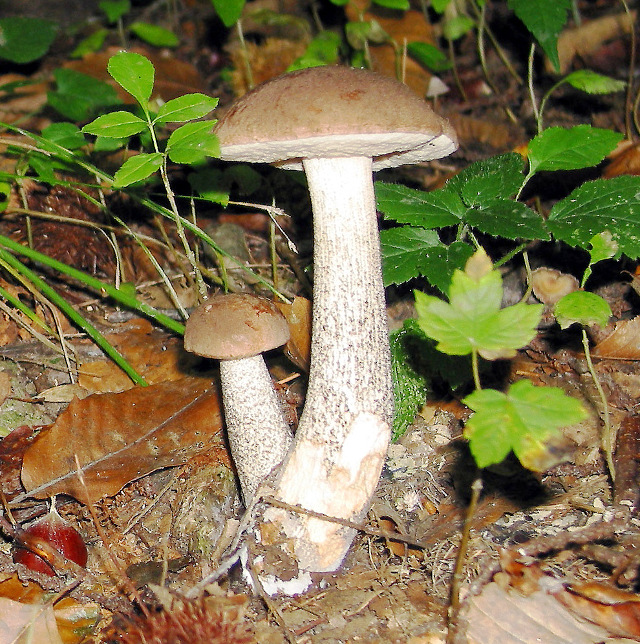
Despite the fact that boletus is usually called boletus, that is, mushrooms with brown caps, in science it is a whole genus of mushrooms, which includes not only brown boletus, but also all kinds of red-cap boletus.And, what is most interesting - there are several types of both. However, the average mushroom picker never bothers about their variety, and distinguishes between these mushrooms only by the color of their caps. Well, because some of them are found under birches, and some under aspens.
Birch trees
Since these mushrooms have been called lumps from time immemorial, we will begin our review of this group with them.
Common boletus
Captured (in all its glory) in the photo above, which is the headline for the obb section. It is found, of course, in birch forests, or mixed, but always with an admixture of birch. It can also grow in the tundra - among dwarf birches, and is often given a sprout taller than the last, which is why it is jokingly called "overbirch" among tundra inhabitants.
Appears in June, often in the first half of the month. It continues to bear fruit for a rather long time - until the first half of October. Nevertheless, everything here depends on autumn, and on how early the frost hits.
Black boletus
It is very similar to the previous species, in fact - its complete twin, it differs only in a slightly darker color. But as a distinctive feature, it is better not to use it, because both brown birch trees are prone to variations in the color of the caps in the dark or light side. Usually mushroom pickers do not distinguish between both of them.
It does not bear fruit as long as a common boletus, usually from July to September. In October it can hardly be found.
White boletus
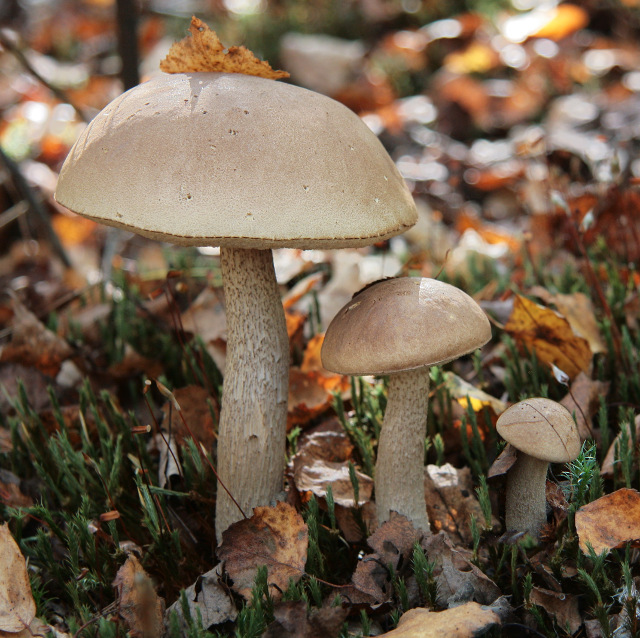
And there is one. It has the lightest color of all brown birches, and sometimes it is completely snow-white. It differs from its previous counterparts in that it reaches for damp, wetlands.
White boletus trees grow from July to the end of September.
Aspen boletus
They differ from brown birch trees in that they form mycorrhiza with aspen. Well, and a brighter color of the hat.

Fruiting from early June to September, in warm autumn it happens in October.
Boletus red
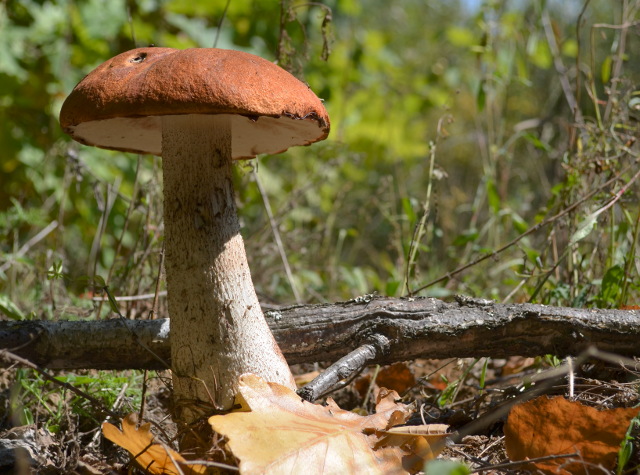
But this fungus is absolutely indifferent to which tree it grows under. The only "requirement" is that it, this tree, be deciduous. But most often it is found in those forests where aspen grows.
Fruiting from June to October. It appears en masse in three "waves": at the end of June, in the middle of July, and also in the second half of August - the first half of September.
Boletus white
It turns out that among the redheads there is its own light (up to full whiteness) variety, which, interestingly, is sometimes ranked among the most real porcini mushrooms (in contrast to the recently considered white boletus). Perhaps this is due to the excellent taste characteristics of the white boletus.
It's funny, but this mushroom avoids deciduous forests, preferring to grow among pines and firs. I have never come across it, although they say that this mushroom is periodically found in the Urals.
Collection time is from June to September.
Sarcoscif alai
It is a saprophytic fungus that grows on decaying trunks and branches of trees, which are usually hidden under foliage. These mushrooms appear very early. The snow has not yet melted to the end, and on the thawed patches one can see beautiful bright hats (bowls) of Scarlet Sarkosciths.
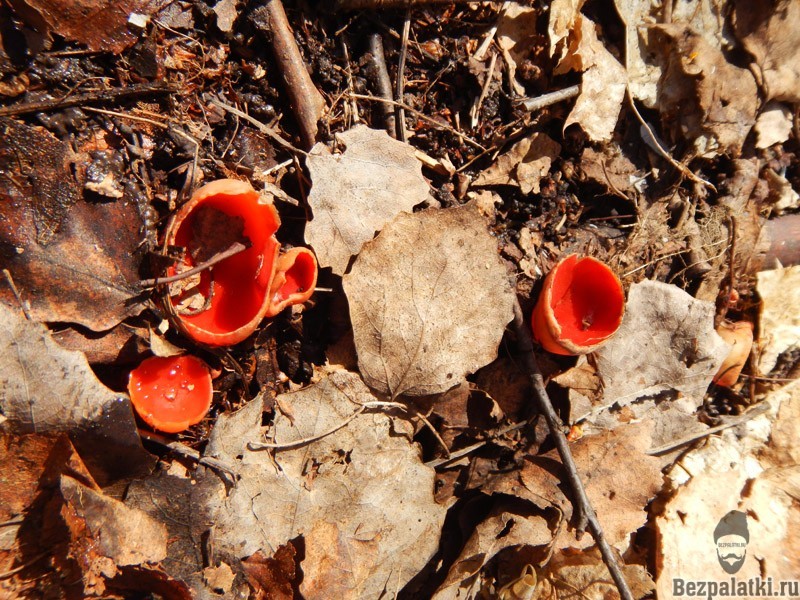
Sarkoscifa is a kind of indicator of the ecological situation; it is not found near factories and factories.
The Sarcoscifa mushroom is not poisonous, which means it can be eaten. But it does not have a special taste, and it is harsh. The mushroom can be fried and used in salads.
The medicinal properties of the mushroom
The fungus helps to stop bleeding. In Russia, the powder prepared from Sarkoscifa was used to stop bleeding. This mushroom was used by the Iroquois tribe to stop bleeding and as an anti-inflammatory agent. The wounds were sprinkled with mushroom powder.
April
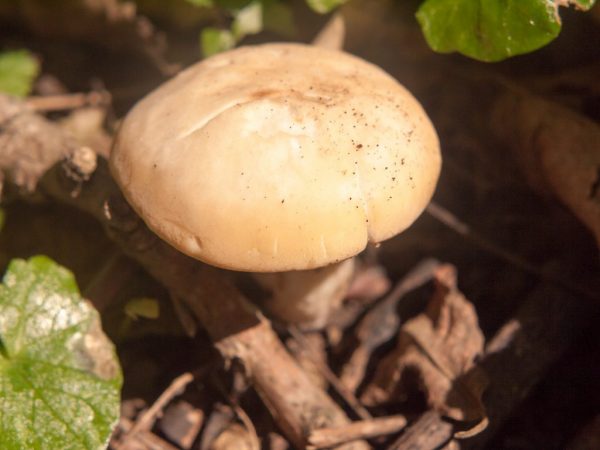
Spring mushrooms taste good
In the second month of spring, the weather is much warmer, and therefore more species of spring mushrooms appear.They occupy not only forest clearings and stumps, but grow in fields, parks and even gardens. Edible April spring mushrooms have a pleasant taste and aroma.
The characteristics of the varieties and their habitat are described in the table below.
| Mushroom name | Description of the fruiting body | Place of growth |
| Giant stitching, Bunched stitching | Irregularly shaped beige-brown hat with deep grooves and dents, outwardly resembling a brain. Giant morel can reach 12-15 cm in diameter. The leg is thin and is located underground. | Pine forests with sandy soil, mixed forests. Grows on the remains of rotten wood and leaves. |
| Morel conical | The body is small in size and cylindrical in shape. The cap is a marsupial, with deep dents resembling a honeycomb, has a light or dark brown color, fits snugly to the lower part - the leg. The leg is white, low, porous inside. | Coniferous forests with rare alders, aspens, birches on the soil with a high sand content. Selects illuminated places - meadows, edges. |
| Oyster mushrooms | Shell-like caps with edges curled inward. Top Width sometimes reaches 17-18 cm... The leg is thin, unable to hold the entire mass. The color changes from gray to ashy with purple. Older specimens fade to white. | Any substrates, rotten wood, old branches, tall stumps. |
| Spring honey mushroom | Small spherical caps with thin legs. The color scheme is brown and beige-brown. There is a girdle on the leg (the remains of a private veil), below its fruiting body is covered with scales. It grows in groups, sometimes growing together by the edges of the fruiting bodies and forming aggregates. | Wood sawdust, rotten branches, stumps. Prefers moist places in the grass. Found in meadows, in the garden, in the forest. |
Recipes for the use of morels in traditional medicine
Stimulation of digestion and improvement of the body.
To prepare the drug, you need a glass of water and a tablespoon of dried morels. Boil the composition for 25-30 minutes, cool and filter. It is recommended to drink it 2-3 times 15 minutes before a meal, 50 grams each.
Tincture for the treatment of blood diseases.
Take four fresh mushrooms or 10 grams of dried ones. Rinse thoroughly, grind, fill with a glass of vodka. The tincture is prepared within a month. After filtration, you need to take it twice a day for a teaspoon, be sure to wash it down with juice or any acidic drink. The course of treatment requires 500 grams of tincture.
Powder for eye diseases.
From the dried morels, you need to make a powder using a coffee grinder. Take ½ dessert spoon powder with a little water in the morning and evening. The time interval between taking the drug should be at least 6 hours.
Recovery from tuberculosis.
A clay pot is required to prepare the product. Fresh morels in an amount of 200 grams are boiled, washed thoroughly, dried, cut into pieces and poured with melted butter. Grease the pot with butter, put mushrooms, 100 grams of black bread crumbs, chopped head of garlic into it and pour everything with homemade sour cream. Next, the pot is placed in the oven and the product is prepared for 3 hours over low heat. Then leave for another hour in the oven after turning off. After tuberculosis, the finished product must be taken twice a day for a tablespoon.
To summarize: The lines are considered poisonous mushrooms, and although in Russia the toxicity of mushrooms is not high (possibly due to the harsh climate), I do not recommend them for use.
Morels are wonderful and very tasty mushrooms with many useful properties. Just remember to boil it first.
Can I eat morels and stitches? How to cook.
Tinder fungus sulfur-yellow
Many people, when they say "tinder fungus", will first of all remember a hefty "flying saucer" that is firmly stuck to an old stump or a fallen forest. Eating these mushrooms is out of the question, all that remains is to offer the beaver as a dessert.However, barely barely breaking through the bark, the still young fruiting bodies of the tinder fungus are tender and juicy, therefore, they are quite usable. But not all, but only certain species, a couple of which were included in our spring list.
Tinder fungus sulfur-yellow - one of them. Its fruiting bodies are somewhat reminiscent of yellow dough that has crawled out through the cracks in the wood. They appear on deciduous, less often coniferous trees in May - approximately in the second half of the month. The mushroom does not bear fruit for long - until the end of June.
We rarely collect it, but in some places abroad it is considered a delicacy and has the nickname "wood chicken"
However, you should be careful with it: there is information that a mushroom grown on conifers, when used, causes poisoning and allergic reactions, the same effect can be observed when eating old fruit bodies
Important: about boiling morels and lines
Before proceeding to the listing of spring mushrooms, it will be useful to mention the nuances of cooking the two most popular groups - morels and stitches.
In almost all sources, it is recommended to pre-boil, or (which is more reliable) for a long time - from 3 to 6 months - to dry these mushrooms in order to avoid poisoning. However, it is known for certain that dangerous toxins are contained only in the lines, and morels (and this is indicated by many experienced mushroom pickers) can be cooked without boiling at all - so they turn out to be an order of magnitude tastier. However, scientists warn: one does not have to.
Depending on the places of growth and weather and climatic conditions, poisonous substances may well accumulate in morels, and the lines can grow with a minimal, practically not dangerous content of toxin, or vice versa - the concentration of poison in them will go off scale, and no boiling or even six-month drying will help.
From this, we can draw the only conclusion: the most reliable way to avoid poisoning is not to collect lines at all, and morels are always boiled or dried before cooking.
Eating lines or not boiled morels, especially those that have not undergone preliminary processing of lines, any mushroom picker carries out at his own peril and risk.
Are the stitches edible?
Russian experts consider these mushrooms to be conditionally edible. In other words, they are good for food, but only after boiling. As for Western specialists, they believe that the lines are poisonous. This is due to the fixed cases of severe poisoning with these mushrooms, some of which were fatal. All these cases happened because people ate the lines in food raw, like morels.
In fact, these mushrooms do contain toxic toxins that are destroyed during heat treatment. Our mushroom pickers recommend to carry out repeated processing of lines. Repeated boiling of these mushrooms destroys toxins, which minimizes the risk of poisoning. Of course, we do not recommend collecting these mushrooms for inexperienced people who do not know how to properly process them.
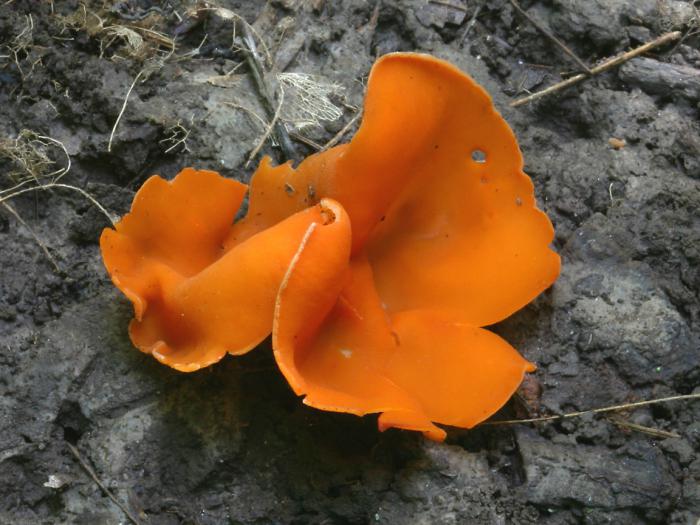
How to cook delicious spring mushrooms
Like everyone else, spring mushrooms are pickled, fried and boiled. However, not all of them are applicable to all types of processing. In addition, there are some original, really interesting recipes - they are listed below.
Morel sauce
Morels with onions and sour cream are especially tasty. First, they are soaked for a couple of hours in cold water, washed and cooked for half an hour at a low boil. And only then they are fried for several minutes, after which they are stewed with onions and sour cream - a very tasty mushroom sauce is obtained, perfect for all main courses.

Morels with onions and sour cream are especially tasty
Stitching recipe
After processing the lines, they are cut into pieces, boiled for another 15 minutes, removed and stewed in sour cream with onions until boiling.And another option is to roll the slices in flour, salt and simply fry in oil for 15 minutes, then add sour cream and also bring to a boil.
Chicken and mushroom pie: the fastest recipe
If you are running out of time, you can do this:
- Take a package of ready-made puff pastry.
- Chicken breast fillet (2 pieces).
- Champignes - 400-500 grams.
Cut the meat into pieces and fry over high heat until half cooked. Fry the mushrooms in the same pan (but without meat) for 10 minutes. Next, a layer of dough is rolled out, the ingredients are laid out on it, after which you need to roll it into a roll. Bake in the oven at 180 ° C for no more than half an hour.
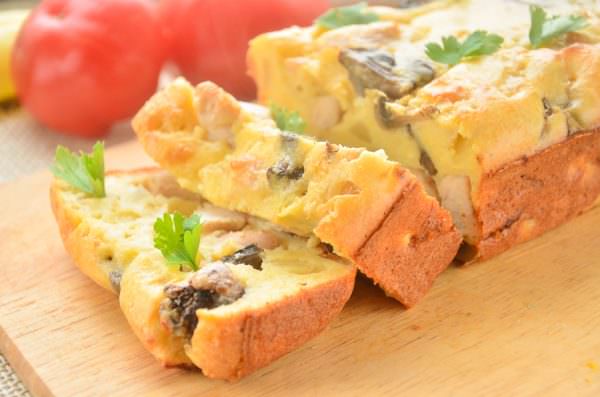
Chicken and mushroom pie
Preparing raincoats
You only need to cook raincoats using the frying method: if you boil them, the fruiting bodies, like a sponge, will absorb water and become completely unpleasant to the taste.
It is also important to consume the fruiting body immediately after collection: even after lying in the refrigerator for a day, the product will lose its taste. And one more rule - immediately before cooking, the shell should be peeled off the cap.
There are several ways to fry:
- Cut into thin slices, season with salt and roll in breadcrumbs. Fry in the same way as a cutlet.
- Make a dough with the consistency of pancakes and fry the pieces in batter.
- Finally, you can simply fry in sunflower oil - the pieces will look like French fries, which will give the dish an extra zest.

